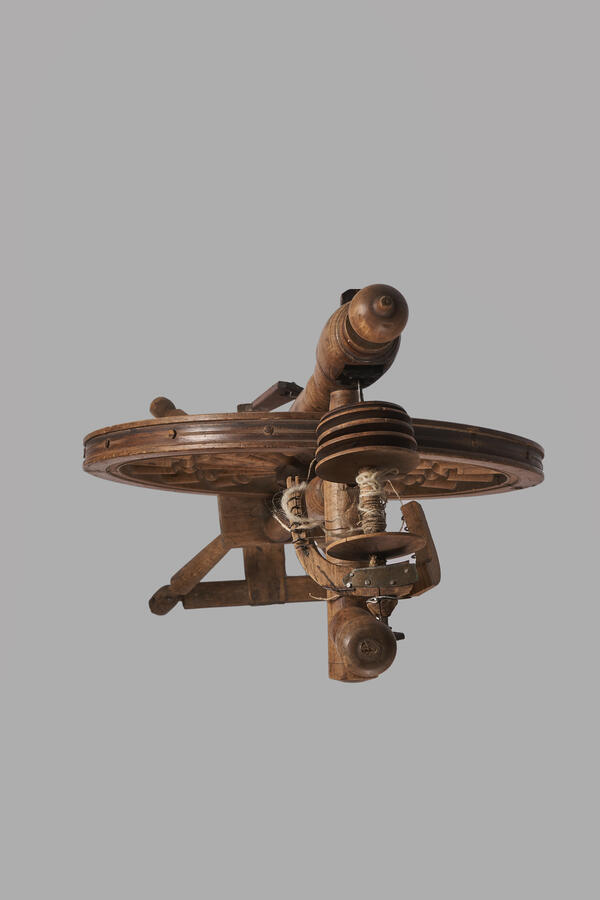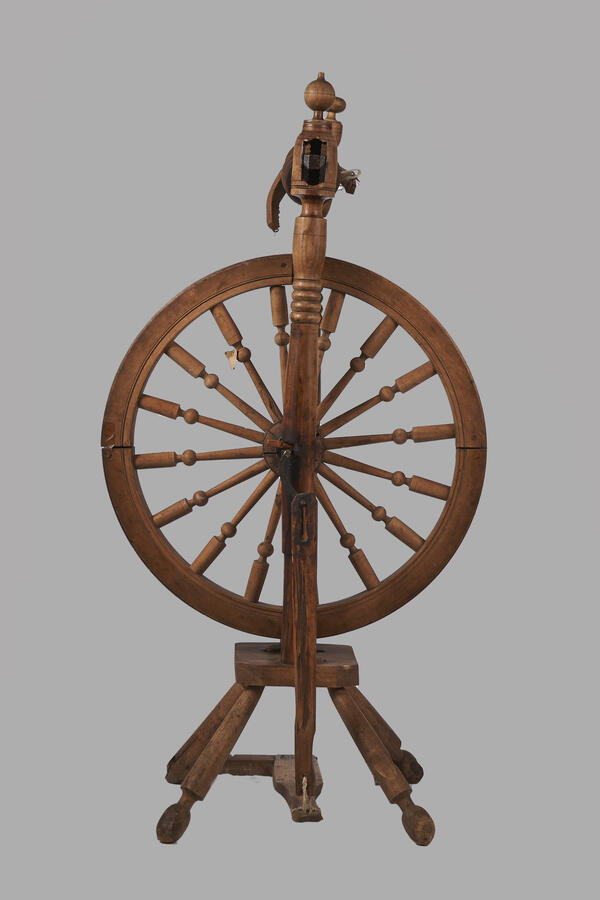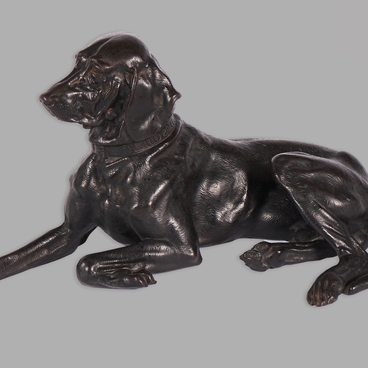A distaff and a spindle are ancient women’s tools used in spinning. The art of spinning and weaving has been held in great esteem by all peoples for a long time.
A spinning wheel is a device for spinning thread or yarn from fibers. It consists of a drive wheel, a flat treadle, a bobbin, a wooden footman, and a leather drive band. The drive band connected the drive wheel to the bobbin, and the wooden footman connected the drive wheel axle to the treadle. All these elements were fixed in a particular order. The drive wheel could be next to or below the bobbin.
Linen fiber or wool was attached to a wooden blade inserted into the upper part of the upright spinning wheel or to an ordinary spindle. To begin spinning, the woman manually twisted a little fiber into a thread, passed it through the hooks of the bobbin and fixed it there. Then, she pressed her foot on the treadle, set the drive wheel in motion, which, in turn, made the bobbin rotate. At the same time, the woman pulled out the fiber with her hand, and the rotating bobbin made it spin into a thread and wind on the bobbin.
The main advantage of a spinning wheel is its efficiency. However, peasants did not use spinning wheels as often as spindles, which were simpler and cheaper.
Over the centuries, different peoples have developed their own forms of spinning wheels and techniques for decorating them. Women spun at cheerful gatherings of village youth and at home. In the old days, a girl would start using a spinning wheel at the age of seven. She had to spin and weave enough to make her dowry and gifts to her relatives. After marriage, the woman would be only occasionally doing this type of work. In those areas where spinning was a trade, a woman spent all her youth spinning. The distaff served as a wedding gift from the groom to the bride. Often a father gave it as a keepsake to his daughter, and a husband — to his wife. Therefore, such an important item in peasant everyday life was decorated with particular care. A beautiful distaff was handled with care and passed down from generation to generation.
The spinning wheel from the “Room of Settler Peasants” was donated to the museum by a resident of Novorossiysk, Maria Efimovna Kadol. She, in her turn, inherited it from her grandmother — Praskovya Uvarovna, a native of the village of Kuleshovka, Krasnodar Territory.
A spinning wheel is a device for spinning thread or yarn from fibers. It consists of a drive wheel, a flat treadle, a bobbin, a wooden footman, and a leather drive band. The drive band connected the drive wheel to the bobbin, and the wooden footman connected the drive wheel axle to the treadle. All these elements were fixed in a particular order. The drive wheel could be next to or below the bobbin.
Linen fiber or wool was attached to a wooden blade inserted into the upper part of the upright spinning wheel or to an ordinary spindle. To begin spinning, the woman manually twisted a little fiber into a thread, passed it through the hooks of the bobbin and fixed it there. Then, she pressed her foot on the treadle, set the drive wheel in motion, which, in turn, made the bobbin rotate. At the same time, the woman pulled out the fiber with her hand, and the rotating bobbin made it spin into a thread and wind on the bobbin.
The main advantage of a spinning wheel is its efficiency. However, peasants did not use spinning wheels as often as spindles, which were simpler and cheaper.
Over the centuries, different peoples have developed their own forms of spinning wheels and techniques for decorating them. Women spun at cheerful gatherings of village youth and at home. In the old days, a girl would start using a spinning wheel at the age of seven. She had to spin and weave enough to make her dowry and gifts to her relatives. After marriage, the woman would be only occasionally doing this type of work. In those areas where spinning was a trade, a woman spent all her youth spinning. The distaff served as a wedding gift from the groom to the bride. Often a father gave it as a keepsake to his daughter, and a husband — to his wife. Therefore, such an important item in peasant everyday life was decorated with particular care. A beautiful distaff was handled with care and passed down from generation to generation.
The spinning wheel from the “Room of Settler Peasants” was donated to the museum by a resident of Novorossiysk, Maria Efimovna Kadol. She, in her turn, inherited it from her grandmother — Praskovya Uvarovna, a native of the village of Kuleshovka, Krasnodar Territory.





